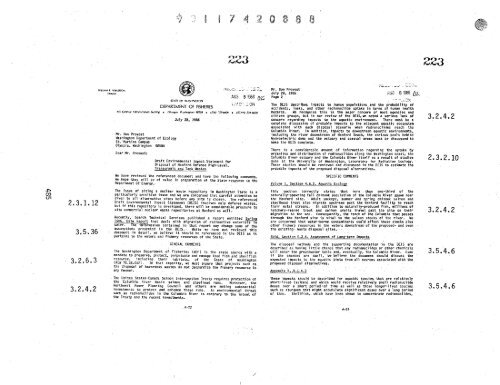EIS-0113_Section_11 - Hanford Site
EIS-0113_Section_11 - Hanford Site
EIS-0113_Section_11 - Hanford Site
You also want an ePaper? Increase the reach of your titles
YUMPU automatically turns print PDFs into web optimized ePapers that Google loves.
9 ^ ^ 0 18 8<br />
1<br />
ZZ3<br />
ON<br />
$i ail IX N t414GT(xJ<br />
DEPARTMENT OF FISHERIES<br />
AU 3 81966 ^ZS<br />
....Oh.<br />
<strong>11</strong>i 6,, lLL .e,,O_Wes, • (M" lta3vgiw sawn . Ib, 75.I(M . • co A" )IM(p<br />
Mr. Don Provost<br />
Washington Department of Ecology<br />
St. Martins Campus<br />
Olympia. Washington 98504<br />
Dear Mr. Provost<br />
July 28, 1986<br />
.Draft Environmental Impact Statement for<br />
Disposal of <strong>Hanford</strong> Defense High-Level,<br />
Transuranic and Tank Wastes<br />
-<br />
Mr. Don Provost<br />
July 28, 1986<br />
Page 2<br />
a.l 81986 ^^<br />
The D<strong>EIS</strong> describes impacts to human- populations and the probability Of<br />
accidents, leaks, and other radionuclide uptake in terms of human health<br />
hazards. We recognize this is the major concern of most agencies and<br />
citizen groups, but in our review of the D<strong>EIS</strong>,we noted a serious lack of<br />
concern regarding impacts to the aquatic environment. There most be a<br />
complete discussion of probable impacts t0 the adjacent aquatic ecosystem<br />
associated with each disposal scenario when radionuclides reach the<br />
Columbia River. in addition, impacts to downstream aquatic environments,<br />
including the river downstream of <strong>Hanford</strong> Reach, the various pools behind<br />
hydroelectric dams and the estuary and coastal areas must be discussed to<br />
make the D<strong>EIS</strong> complete.<br />
There is a considerable amount of information regarding the uptake by<br />
organisms and distribution of radionuclides along the Washington coast, the<br />
Columbia River estuary and the Columbia River itself as a result of studies<br />
done at the University of Washington, Laboratory for Radiation Ecology.<br />
These studies should be reviewed and discussed in the D<strong>EIS</strong> to estimate the<br />
probable impacts of the proposed disposal alternatives. -<br />
3.2.4.2<br />
2.3.2.10<br />
We have reviewed the referenced document antl have the following comments.<br />
We hope they will be of value in preparation of the State response to the<br />
Department of Energy.<br />
SPECIFIC COMMENTS<br />
Volume 1, <strong>Section</strong> 4.6.2. Aquatic Ecology<br />
A<br />
co<br />
2.3.1.12<br />
3.5.36<br />
The issue of siting a nuclear waste repository in Washington State is a<br />
partieolarly sensitive issue and weare. concerned that careful attention be<br />
diver to all alternative s sites before any site is chosen. The referenced<br />
Draft Environmental Impact Statement (D<strong>EIS</strong>) involves only defense wastes,<br />
but if this repository is developed, there will be considerable pressure to<br />
site commercial nuclear waste repositories at <strong>Hanford</strong> as well..<br />
Recently, Search Technical Services published a report ent i tled S rim<br />
19.6, Data Report that deals With migration Of radioactive matCli a<br />
water] nTormation contained im that report may change some of the<br />
assumpt document on presented in the - GET 5 While We have not reviewed this<br />
in detail, we believe it should be referenced in the D<strong>EIS</strong> as it<br />
pertains to the waters and fishery resources of the State.<br />
This section correctly states that more than one-third of the<br />
naturally-spawning fall Chinook population of the Columbia River spawn near<br />
the <strong>Hanford</strong> site. Adult sockeye, summer and spring. Chinook salmon and<br />
steelhead trout also migrate upstream past the <strong>Hanford</strong> facility to reach<br />
their natal streams. in addition to naturally-produced fish,. millions of<br />
hatchery-reared trout and salmon smelts travel past the site on their<br />
migration to the sea. Consequently,. the reach of the Columbia that passes<br />
through the <strong>Hanford</strong> site is vital to the salmon stocks Of the river.. We<br />
are concerned that water-borne contaminants could affect these stocks plus<br />
other fishery resources in the waters downstream of the proposed- and even<br />
the existing- waste disposal sites.<br />
ibid, <strong>Section</strong> 5.2.4. Assessment of Lang-term Impacts<br />
3.2.4.2<br />
3.2.6.3<br />
GENERAL COMMENTS<br />
The Washington Departakht of Fisheries (WDrI is the state agency with a<br />
mandate to preserve, protect, perpetuate and main, food fish and shellfish<br />
re5 ace, including their habitats, of the State of Washington<br />
(RCW ]5.08.012). In that capacity, we must ensure that projects such as<br />
the disposal of hazardous wastes do not . jeopardize the fishery resource in<br />
any Manner.<br />
The disposal Methods and the supporting documentation in the D<strong>EIS</strong> are<br />
described as bovinelittle chance that any radionuclides Or other chemicals<br />
will enter the groundwater table and, eventually, the Columbia River. Even<br />
if the chances are small,' we believe the document should discuss the<br />
ekpected impacts to the aquatic biota from all sources associated with the<br />
proposed disposal alternatives.<br />
bREand, k R,. R.1.4:3<br />
3.5.4.6<br />
3.2.4.2<br />
The united States-Canada Salmon Interception Treaty requires protection of<br />
the Columbia River Basin salmon and steelhead runs. Moreover, the<br />
Northwest Power Planning Council and others are making substantial<br />
investments to protect and enhance these runs. An environmental threat<br />
such as radionuclides in the COI umbis River is contrary th the intent of<br />
the Treaty and the recent investments.<br />
These impacts should be described for aquatic species that are relatively<br />
short-lived (salmon) and which would receive relatively small radionuclide<br />
doses over a short period ^ of time - as' well as those longer-lived species<br />
such as sturgeon that might accumulate significant doses over a long period<br />
of time. Shellfish,.. which have been shown to concentrate radionuclides,<br />
3.5.4.6<br />
A-22<br />
A-23

















